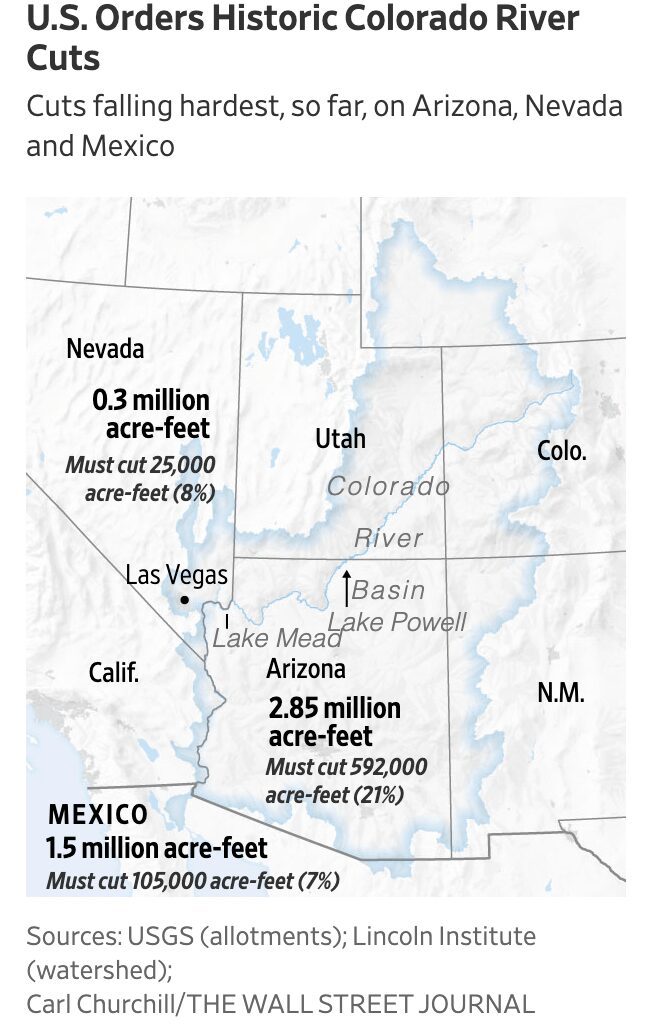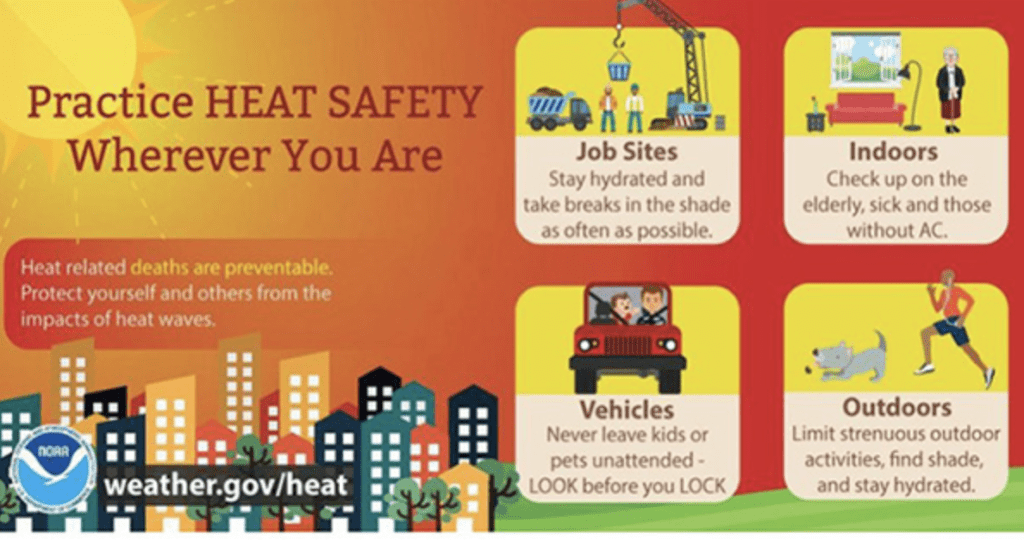Daniel Salzler No. 1165
EnviroInsight.org Three Items September 2, 2022
—————Feel Free To Pass This Along To Others——————
If your watershed is doing something you would like others to know about, or you know of something others can benefit from, let me know and I will place it in this Information newsletter.
If you want to be removed from the distribution list, please let me know.
Please note that all meetings listed are open.
Enhance your viewing by downloading the pdf file to view photos, etc. The
attached is all about improving life in the watershed. If you want to be removed from
the distribution list, please let me know. Please note that all meetings listed are open.
Check our website at EnviroInsight.org\
1. U.S. Orders Historic Colorado River Cuts to Drought-Stricken Southwest States. Arizona, Nevada and Mexico bear brunt of latest reductions in effort to save Lake Mead, Lake Powell

The federal government has declared an unprecedented new stage to the water shortage afflicting the Colorado River, triggering cutbacks likely to deepen economic damage to the Southwest driven by a long-running drought.
The cuts of less than one million acre-feet are lower than the two million to four million officials of the Bureau of Reclamation had told the seven states that use the river, as well as Mexico, to prepare for in an advisory two months ago. They notably leave out California, the river’s largest user, which would have been affected by bigger cuts.
An acre foot is enough water for a typical family of four for one year.
Bureau officials said they were prepared to impose additional cuts if cooperative efforts to achieve savings to prop up two of the river’s biggest reservoirs, Lake Mead and Lake Powell, don’t work. Officials said Tuesday that both reservoirs reached what is classified as a Tier 2 shortage for the first time.

“The system is approaching a tipping point and without action we cannot protect the system and the millions of Americans who rely on it,” Bureau of Reclamation Commissioner Camille Calimlim Touton said in a press briefing.
As of August 16, 2022, Lake Mead stood at an elevation of 1042.4 feet, the lowest since Hoover Dam was completed in 1936 to form the reservoir. Lake Powell stands at 3,534 feet, or 166 feet below its capacity.
The amount of water states and Mexico must lose is based on their priority in longstanding agreements. Under the new cuts announced August 16, 2022,, Arizona must stop using 592,000 acre-feet, Nevada 25,000 and Mexico 104,000 in 2023. The total of 721,000—enough to meet the annual needs of Las Vegas—is about 100,000 higher than the cuts that were ordered after a first-ever Tier 1 shortage was declared last year.

Unusually strong monsoon rains this summer have helped replenish dry soils and reduce wildfire risk, but they added little to the reservoirs in part because so much water evaporates in the heat, water officials say. The reservoirs depend mostly on snowmelt runoff, which has sharply declined because of the warming climate, the officials said.
The region is locked in its worst drought in 1,200 years, according to a University of California, Los Angeles-led study earlier this year.
Bureau officials had warned in June that cuts were likely coming and put affected states on notice to either come up with reductions on their own or face having the agency do it for them.
However, the states so far have been unable to agree. A tension point has been the amount of water used by farmers, whose fields soak up as much as 80% of the Colorado’s water used by people, rather than for environmental purposes.

Reducing such allocations could raise food prices, according to agriculture officials. Reductions for cities are also likely, which could stunt their growth, urban planners say.
In addition, the Bureau of Reclamation has said both Lake Mead and Lake Powell soon could fall below the level needed to generate hydropower, which could disrupt the region’s electric grid.
The 1,450 mile Colorado River fuels $1.4 trillion in annual economic activity in the basin states, according to a 2015 study by Arizona State University.
Officials in Arizona objected to the amount of cuts that the federal government is demanding of them. “It is unacceptable for Arizona to continue to carry a disproportionate burden of reductions for the benefit of others who have not contributed,” Tom Buschatzke, director of the Arizona Department of Water Resources, and Ted Cooke, general manager of the Central Arizona Project water agency, said in a statement.
Federal officials said on August 16, 2022 they were still hoping states will come up with a way to meet the necessary reductions. The officials also said they have begun administrative actions that would allow them to order states to take mandatory actions if they don’t reach their own agreements soon.
Officials offered no timeline on when any of such actions might go into effect. “We believe the solution here is one of partnership, but we need to be able to protect the system,” Ms. Touton said.
The bureau is also looking at potential engineering fixes, such as allowing water to be released from the reservoirs at lower elevations. In addition, they plan to use $8.3 billion in federal infrastructure funding for efforts such as conservation and storage.
Some water users said a final plan could take at least two more months to finish, because the water rights are so complex they have to work together on any agreements.
In a letter Monday to federal regulators, John Entsminger, general manager of the Southern Nevada Water Authority, accused other users of coming up with unreasonable proposals—including for “drought profiteering.” In an interview, he singled out farming districts in Arizona and California that have offered to use less water on their crops in return for cash payments.
Farm officials say they have conserved, too, and called the money-for-water plan necessary to quickly achieve savings and help offset the economic impact.
In Yuma County, Ariz., four irrigation districts have put together a plan to pay farmers $1,500 for each acre foot of water they don’t use over 935,000 acres there over the next four years, said Wade Noble, general counsel for the districts.
The arrangement would represent a roughly one-fifth reduction in the farmers’ water use, which they would attempt to make up by improving crop yields. They could get compensation from $4 billion in drought relief Sen. Kyrsten Sinema (D., Ariz.) negotiated to include in the Inflation Reduction Act, which President Biden signed Tuesday.
By Jim Carlton, Wall Street Journal August 16 2022

2. Quick Update On PFAS, PFAO, Etc. The U.S. EPA is proposing to designate two per- and polyfluoroalkyl substances (PFAS) chemicals, perfluorooctanoic acid (PFOA) and perfluorooctanesulfonic acid (PFOS), as hazardous substances under the Comprehensive Environmental Response, Compensation, and Liability Act (CERCLA). The EPA is recommending the level for drinking water, contaminated by PFOS and PFOA at 4 ppt.
The two man-made chemicals, PFOA and PFOS were used in consumer products under brand names like teflon and Scotchguard beginning in the 1950’s because of their non-stick and water repellant qualities. Known as “forever chemicals” they infiltrate people and the environment without breaking down.
Manufacturers in the U.S. have ceased making the two chemicals and turned to others with similar qualities. But PFOA and PFOS have been found in the soil and groundwater of hundreds of communities around the country, near military bases, chemical plants, paper mills and landfills. The chemicals have been found in milk and other food products and have contaminated drinking water. This is linked to o the most common form of liver cancer in humans.
At the level of 0.004 ppt, 2.2 gallons of PFOA is capable of contaminating one quadrillion gallons of water. Source: August WWDMag.com and Wall Street Journal, August 27, 2022 and Inside Climate News
3. OSHA:Safely Working In Outdoor And Indoor Heat Environments. Millions of U.S. workers are exposed to heat in their workplaces. Although illness from exposure to heat is preventable, every year, thousands become sick from occupational heat exposure, and some cases are fatal. Most outdoor fatalities, 50% to 70%, occur in the first few days of working in


warm or hot environments because the body needs to build a tolerance to the heat gradually over time. The process of building tolerance is called heat acclimatization. Lack of acclimatization represents a major risk factor for fatal outcomes.
Occupational risk factors for heat illness include heavy physical activity, warm or hot environmental conditions, lack of acclimatization, and wearing clothing that holds in body heat.
Hazardous heat exposure can occur indoors or outdoors, and can occur during any season if the conditions are right, not only during heat waves.
Heat Related Illnesses Symptoms and First Aid
Heat Stoke
Confusion, slurred speech, unconsciousness, seizures, heavy sweating or hot,
dry skin, very high body temperature, fast heart rate
Heat Cramps
Muscle spasms or pain usually in arms, legs, arms or trunk
Heat Syncope
Fainting, dizziness
Heat Rash
Cluster of red bumps on skin. Often appears on neck, upper chest and skin folds
Workers who are new to working in warm environments are at increased risk of heat-related illness. See the Protecting New Workers section of this website for more details. Especially during a worker’s first few days, absolutely all symptoms should be taken seriously. Workers who develop symptoms should be allowed to stop working. They should receive evaluation for possible heat-related illness. Source: https://www.osha.gov/heat-exposure
Copyright: EnviroInsight.org 2022
